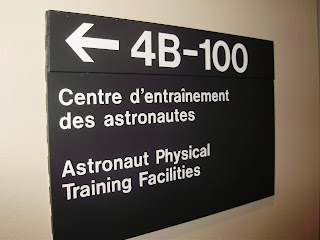Thurs June 11Technical Tour of The Institute for Biomedical ProblemsOn the last day of the conference, attendees were taken on one of three technical tours. I (with some regret, as all three sounded fantastic) chose the tour of the Institute for Biomedical Problems, Russia's main center for space exploration human factors research, and home of
MARS-500. Our group was small -- better for conversation -- and included several top-notch HF researchers, such as the very charming
Chiaki Mukai.
There were fascinating tidbits in every corner, such as a display of Russian space food, with a familiar-looking bottle in the middle:

and a doll kitted out with the Center's "Penguin" suit, which is threaded with bungees to force the body's posture muscles to work out in microgravity:

This is the center that monitors the astronauts' physical and psychological states:

The interactive highlight was getting to play with the lab equipment. I clobbered my way to the front of the group to volunteer for the dry immersion tank. The idea is to simulate weightlessness by floating in water, while protected from the actual wetness by a giant tarp. It was like being swallowed by a flabby waterbed. Here's me going...

...going...

...going...

...gone.

I hogged the dry immersion tank, so it was only fair that someone else got to try the vertical treadmill:

Finally, we got to see the MARS-500 facility, where a six-member crew is locked in, simulating the journey to Mars:

They're about 3/4 of the way through their 105 day pilot study, so we couldn't go in, but we did spend some time in the control center, watching the all-male crew pump weights (playing to the audience to some extent, I suspect). I'm going to submit a study for the full 500-day experiment, so who knows - I might be back!



















